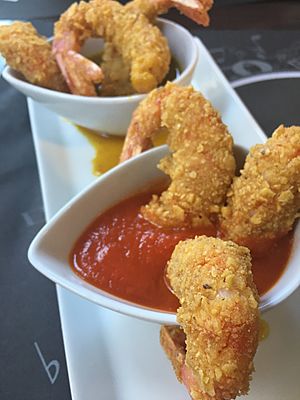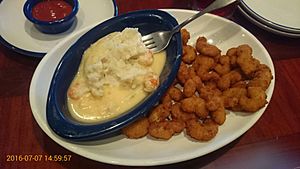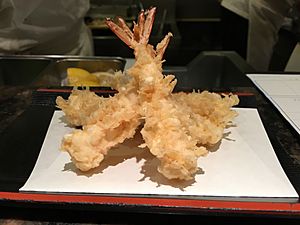Fried shrimp facts for kids
Shrimp and prawn dishes are often prepared by frying. This means cooking them in hot oil. There are many different ways to make them.
Contents
Popcorn Shrimp
Popcorn shrimp are small shrimp fritters. A fritter is food coated in batter and deep-fried. They are bite-sized, like popcorn!
Cajun popcorn is a similar dish. It uses crayfish tails instead of shrimp. It's also full of spices, giving it a bold flavor.
Coconut Shrimp
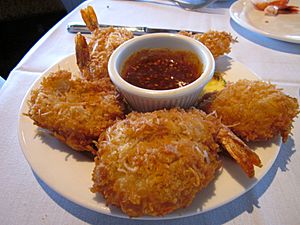
Coconut shrimp dishes are super crunchy. They are made by dipping peeled shrimp in a liquid mixture called batter. Then, they are covered with lots of grated coconut. Finally, they are deep-fried until golden and crispy. These are often served with a sweet chili sauce.
Fried Shrimp Around the World
Japan
Japan has two popular deep-fried prawn dishes. They are called ebi tempura and ebi furai. The main difference is how they are coated. Tempura is never breaded. Furai dishes, however, are always breaded.
Japanese chefs often straighten prawns before cooking. They make small cuts on the prawn's belly. Then, they bend it backward to make it straight. They believe this makes the prawns look nicer.
Ebi Tempura
Ebi tempura (or ebiten) is a prawn tempura. It has a light and fluffy coating. You can eat it as a main dish. It often comes with a soy-based dipping sauce or salt.
Ebi tempura can also be part of other meals:
- Over noodles: You might find it in tensoba or tempura udon. But remember, these noodle dishes don't always have prawns. They might have other tempura ingredients.
- On rice: Tendon is tempura donburi. This means tempura served over a bowl of steamed rice. Sometimes, the tempura is dipped in a thick, sweet sauce before serving.
- Rice ball snack: Tenmusu is a rice ball (called onigiri) topped with a shrimp fritter. It's a popular snack.
Ebi Furai
Ebi furai is a prawn dish that is breaded and deep-fried. It has a darker color and a crunchy texture.
To prepare ebi furai, the legs and most of the shell are removed. The head is also taken off, but the tail is left on. The gritty digestive tract is carefully removed. The prawn is then straightened. Next, it's coated with flour, beaten egg, and Japanese breadcrumbs called panko. Finally, it's deep-fried in hot cooking oil.
Ebi furai is often eaten with different sauces. These include a thick Worcester sauce, a squeeze of lemon, or tartare sauce. Long ago, a type of prawn called kuruma ebi was used. Today, many places use the cheaper black tiger shrimp.
It's believed that ebi furai was created around 1900. It appeared in Western-style restaurants in Tokyo. Other similar dishes, like tonkatsu (fried pork cutlet), were also created around that time.
Ebi furai is a common item in Japanese bento boxes. A bento is a packed lunch. So, ebi furai bentō is a popular lunchbox choice.
Ebi furai became famous in the city of Nagoya because of a joke. In the 1980s, a Japanese celebrity named Tamori made fun of the Nagoya dialect. He joked that people from Nagoya would call ebi furai "ebi furyaa." This wasn't true, but it made people connect Nagoya with "ebi furyaa." Restaurants in Nagoya then started making dishes actually named ebi furyaa. They even created a dish that looked like the Golden shachi (a mythical creature) from Nagoya Castle.
Other Japanese Shrimp Dishes
Ebi katsu is different from ebi furai. It's made from surimi, which is a paste of shrimp meat. This paste is breaded and deep-fried. So, it's not a whole prawn.
Shrimp kakiage is a type of tempura. It's light, airy, and crunchy. It's made from chopped prawns or small whole shrimps, like sakura shrimp. These are mixed together and then fried.
Korea
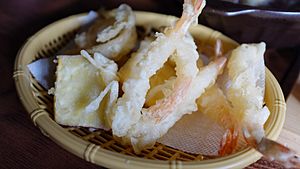
In Korean cuisine, fried shrimp is called saeu-twigim (새우튀김). It's a popular street food. You can often find it at snack bars called bunsikjip. It's also a common anju, which means food eaten with alcoholic drinks like beer. Other popular fried snacks include ojingeo-twigim (fried squid).
Philippines
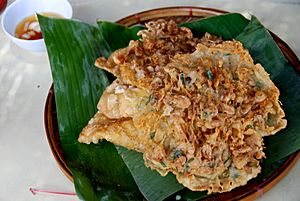
The Philippines has many fried shrimp dishes. Some examples are camaron rebosado (battered shrimp), okoy (battered shrimp pancakes), halabos na hipon (shrimp cooked in its own juices or soda), and nilasing na hipon (shrimp marinated in alcohol).
Camaron rebosado is a deep-fried battered shrimp. It's usually served with sweet and sour sauce. Large shrimp are peeled and soaked in a mix of calamansi juice, salt, and black pepper. Then, they are coated in a batter made from egg, flour, and corn starch. Finally, they are deep-fried.
Okoy is another Filipino deep-fried dish. It often uses small shrimp that still have their shells on. The batter for okoy is special. It's traditionally made from galapong, which is ground soaked glutinous rice. This is mixed with vegetables like calabaza (a type of squash), sweet potatoes, or cassava. Other vegetables like carrots, onions, and green papaya are also added. The mixture is deep-fried into flat, crispy pancakes. Okoy is traditionally served with a dipping sauce made from vinegar.
See also
 In Spanish: Gamba frita para niños
In Spanish: Gamba frita para niños


